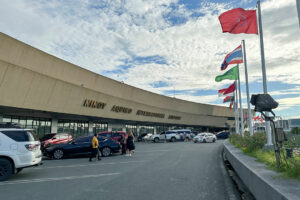By Ashley Erika O. Jose, Reporter
THE offer of San Miguel Corp. (SMC) consortium to rehabilitate and operate the Ninoy Aquino International Airport (NAIA) may face challenges as the financial viability of the project will heavily depend on the changing market environment, an analyst said.
“The consortium should provide detailed financial projections outlining their expected revenue streams, operating expenses, capital expenditures, and cash flow forecasts over the duration of the contract,” Globalinks Securities and Stocks, Inc. Head of Sales Trading Toby Allan C. Arce said in a Viber message to BusinessWorld on Sunday.
“These projections will help assess whether the proposed revenue share is feasible and sustainable in the long run,” he added.
He said the financial viability of the project will depend on the travel demand in the region, competition from other airports, and the changing economic environment that could influence travel patterns.
Last week, the Department of Transportation (DoTr) awarded the contract to rehabilitate, operate, and maintain NAIA to a consortium led by SMC.
The SMC SAP & Co. Consortium, composed of San Miguel Holdings Corp., RMM Asian Logistics, Inc., RLW Aviation Development, Inc., and Incheon International Airport Corp. (IIAC), has proposed to allocate 82.16% of NAIA revenues to the government.
The 15-year concession agreement for NAIA can be extended for a further 10 years based on the consortium’s performance. The SMC-SAP group plans to invest a total of P122.3 billion over a 25-year period.
The group, based on the concession agreement, will pay an upfront payment of P30 billion and P2 billion annuity pay aside from the revenue share.
With this, the government is expected to receive a payment of P36 billion a year or about P900 billion for the period of the concession agreement.
“Our proposal is designed not only to elevate NAIA to world-class standards but also to ensure that the government benefits from the most advantageous revenue-sharing agreement. This aims to secure a favorable outcome for our shareholders while prioritizing fairness and long-term sustainability over immediate profits,” SMC said in a statement.
The company is also constructing an international airport in Bulacan.
“The payment to the government consists of three things: the P30-billion upfront payment, P2-billion annuity, and the 82% of revenues. If you add these up that’s a total of P900 billion for the duration of 25 years,” Transportation Undersecretary Timothy John R. Batan said in a media briefing.
The notice of award for the NAIA-PPP project was issued to SMC-SAP on Feb. 16, Transportation Secretary Jaime J. Bautista said, adding that the two other bidders were informed of the decision.
Mr. Batan said the bidders had submitted challenges and disputes regarding the bidding but all of the disputes put forward had already been resolved by the pre-qualification bids and awards committee (PBAC).
“Offering an 82% revenue share to the government suggests a significant commitment to public benefit and potentially a lucrative deal for the government. However, the sustainability of this offer depends on various factors such as the total revenue generated by the upgraded NAIA, operating expenses, maintenance costs, and profit margins,” Globalinks Securities’ Mr. Arce said.
He said the group’s ability to efficiently manage and operate the airport will directly impact its financial performance.
“Assessing and mitigating potential risks such as construction delays, cost overruns, regulatory changes, and geopolitical factors is crucial for ensuring the sustainability of the project,” he said.
Nigel Paul C. Villarete, senior adviser on PPP at the technical advisory group Libra Konsult, Inc., said the Philippines will certainly benefit from the capability of SMC’s partner, South Korea’s IIAC, the operator of Incheon International Airport.
“As far as operating airports are concerned, Incheon Airport has been operated well by IIAC so we should expect NAIA to be operated properly as well. With respect to sustainability (of the revenue share offer), the concession agreement should have addressed this well [covering] all possible scenarios and eventualities that might happen within the concession period,” he said.
For his part, Rene S. Santiago, former president of the Transportation Science Society of the Philippines said with SMC-SAP’s offer being significantly higher than the other bidders, the DoTr has no choice but to award the concession agreement to the group.
“Let us assume that the bid evaluation committee did their job, and cleared the capability of SMC’s bid. With such a price bid, the same committee has no other option but to award. Else, a court challenge,” Mr. Santiago said.
The NAIA upgrade project aims to increase the current annual passenger capacity of NAIA to at least 62 million from the current 35 million.
For 2024, the Manila International Airport Authority has earlier said that it is expecting domestic and international passenger service charge revenue to reach P5.29 billion this year, a 25% increase over the estimated P4.22 billion for 2023.
The revenue from rental fees is expected to increase by 4% to P2.08 billion, concession privilege fees by 16% to P1.46 billion, and aeronautical fees by 19% to P5.32 billion.
A 24% increase to P7.36 billion is expected in the maintenance and other operational expenses.
The Tourism department reported 5.45 million international visitors in 2023, surpassing the year’s target of 4.8 million. For 2024, the department aims to attract 7.7 million international visitors.






